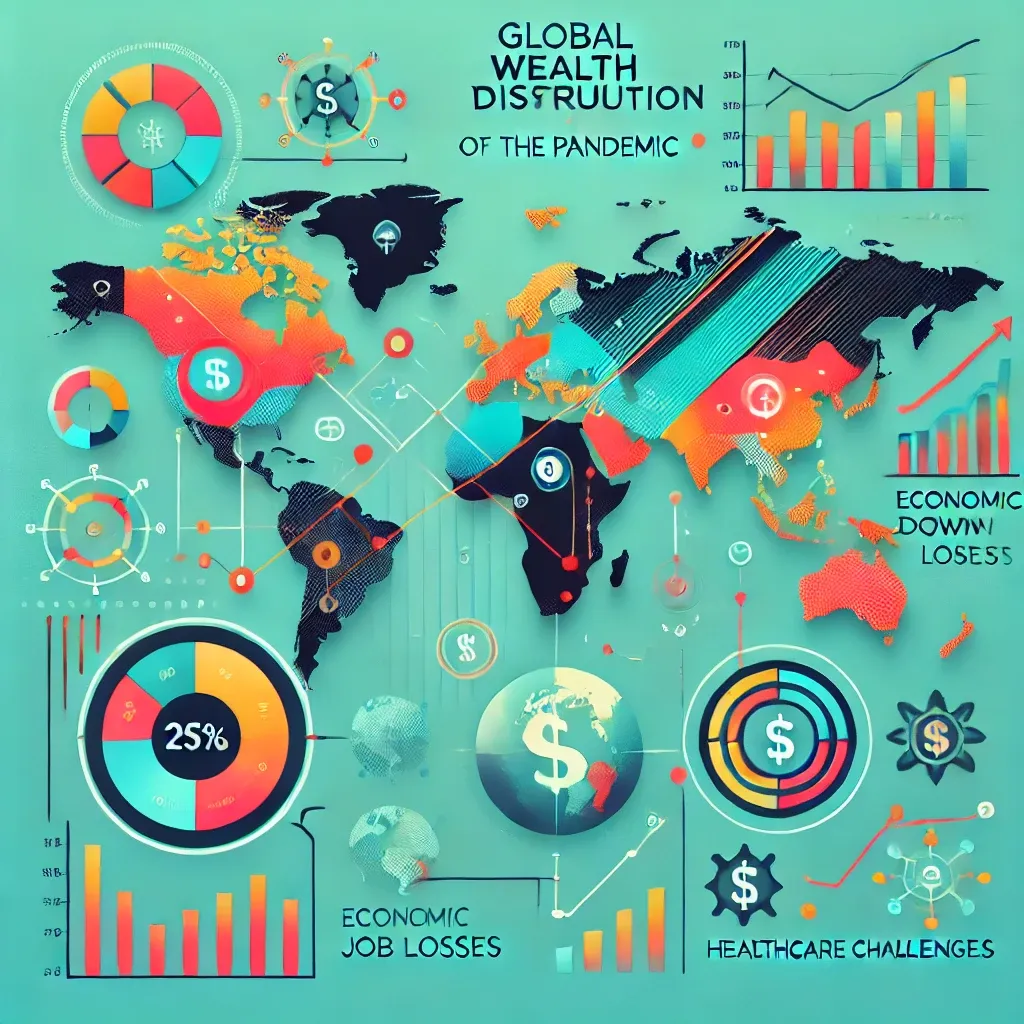How has the pandemic affected global wealth and the distribution of wealth?

- How has the pandemic changed global wealth and its dynamics?
- How do economic changes affect the level of well-being of the population?
Definition of well-being
Credit Suisse interprets the concept of wealth as the total value of financial and real assets held by households. This concept primarily includes real estate, excluding liabilities.
The impact of the coronavirus pandemic
The coronavirus pandemic became an unexpected catalyst for increasing wealth levels among a large number of people. The results of this crisis were surprising and contradicted most predictions. At the beginning of 2020, it was clear that the epidemic was negatively impacting the global economy, especially in the context of a decline in gross domestic product.
As a result, financial markets experienced a sharp decline. In February and March, there was a crash in stock prices worldwide, leading to a reduction in global wealth by 4.4% from January to March, with a per adult figure of 4.7%.
Restoration of financial markets
Nevertheless, thanks to the prompt measures taken by governments and central banks, financial markets managed to recover by the end of June. Remarkably, after that, stocks continued to rise and reached historic highs by the end of the year. In addition, the real estate sector also felt optimistic, which contributed to a rapid increase in housing prices.
Growth of global wealth
Such a significant increase in asset values has contributed to a sharp rise in wealth worldwide. Over the past year, global wealth has grown by an impressive $28.7 trillion, and by the end of 2020, the total wealth reached $418.3 trillion, which is an increase of 7.4%.
- On average, the wealth of an adult has increased by 6% and reached a new record of $79,952.
The paradox of growing wealth
A remarkable paradox: the countries that suffered the greatest losses from the pandemic were able to achieve the most significant successes in per capita wealth growth. Never before have such sharp discrepancies been observed between data on household assets and the state of the global economy.
Dynamics of exchange rates
The dynamics of exchange rates also had a significant impact on the level of wealth. Changes in wealth per capita have become a good indicator for analyzing the situation in various regions. The data presented shows that the highest growth in wealth per adult (in US dollars) was demonstrated by:
- Switzerland (adding $70,729)
- Australia ($65,695)
- Belgium and the USA (over $50,000)
- Germany, the Netherlands, and the United Kingdom (over $40,000)
In some countries, such as the USA, the increase in asset prices also contributed to this growth, but the main factor was the rise in the currency exchange rate.
Disadvantages and losses
Despite the complexity of the situation, only a few countries showed a decline in per capita wealth in 2020, and the losses they incurred were relatively small. Currency devaluation negatively impacted the level of per capita wealth in countries like Brazil, Chile, and Russia; however, the decline was less than $10,000.
Economic changes and their consequences
As a result of economic transformations, the United Arab Emirates experienced the most significant losses, with the average wealth level dropping by $18,540. Hong Kong also found itself in a difficult situation, losing $26,419. This information pertains to the financial changes that occurred among individual citizens in 2020, focusing on key areas such as the real estate market, population migration, and investment activity. When looking at the Russian Federation, it can be noted that the financial situation of residents ranges between $25,000 and $100,000.
Global wealth map
The most vivid illustration of wealth levels is represented through a global map reflecting the status of countries based on their gross domestic product per capita. In this graphical representation, the highest indicators are observed in:
- North America,
- Western Europe,
- in prosperous regions of East Asia,
- in certain areas of the Pacific region,
- in the Middle East,
- in some countries of the Caribbean islands.
Middle-income group
China and Russia are characterized as the core of the group.“middle level of prosperity”which also includes nations with incomes ranging from 25,000 to 100,000 dollars per person. This category includes:
- new member states of the European Union,
- developing Latin American countries,
- Middle Eastern countries.
This range of funds defines that the group includes countries with assets from 5,000 to 25,000 dollars.

- India,
- Indonesia,
- Iran,
- Philippines,
- most Latin American nations,
- developed countries south of the Sahara, such as South Africa.
Poor wealth
At the very lowest level, which can be referred to as“poor wealth”There are countries where the level of wealth does not reach 5,000 dollars. These are usually countries in Central Africa.
Millionaires in the world
For the first time on a global scale, it has been recorded that more than 1% of the adult population worldwide has become millionaires in dollars. The so-called“pyramid of wealth”It provides a visual representation of the distribution of financial resources among adult individuals. According to a Credit Suisse report, in 2020, approximately 55% of the adult population of the planet (around 2.9 billion people) had assets below $10,000. In developed economies, this figure is about 30%, although many of these individuals are at this level temporarily due to economic hardships or unemployment. In conditions of poverty, over 80% of residents in developing countries live at a similar financial level, which has already become a common practice.
Growth of wealth
The next category includes people with assets ranging from $10,000 to $100,000. The number of citizens with such assets has more than tripled over two decades – from 507 million in 2000 to 1.7 billion by 2020. These changes reflect the overall improvement in the economic situation in developing countries, especially in China, and the expansion of the middle-income group.
Wealth segmentation
The upper middle class includes individuals with assets ranging from $100,000 to $1 million; typically, these are representatives of the middle class in highly developed countries. At the very top...“pyramids”There are dollar millionaires, of which there were 56 million in 2020, accounting for 1.1% of the entire adult population of the planet. This segment is starting to take an increasingly significant share of the total accumulated wealth.

Conclusion
In conclusion, it should be noted that the events experienced by the world in 2020 due to the COVID-19 pandemic had a contradictory impact on global wealth. Based on research from Credit Suisse, we observe a remarkable paradox: despite a significant decline in the global economy, the value of assets has increased, which in turn has led to a rise in wealth in most countries.
Throughout the article, I tried to demonstrate how rapidly the conditions in the financial markets changed and how decisive actions by governments and central banks helped avoid more serious consequences. This not only speaks to the flexibility of global financial systems but also to their ability to adapt to new challenges. Interestingly, the greatest successes in increasing wealth were shown by those countries that suffered the most from the pandemic.
The influence of exchange rates
It is also important to emphasize the different dynamics of currency exchange rates and their impact on the financial condition of households around the world, which confirms the extensive uneven growth in the level of wealth. The identified pyramid structure of wealth distribution shows:
- How different income levels are associated with economic growth;
- It highlights the inequality that exists globally.
The growth in the number of dollar millionaires
We also see positive changes: the number of dollar millionaires has increased, which indicates a growth in financial opportunities for a certain segment of the population. However, we must not forget that55%The adult population of the world still has a net worth of less than$10,000And this presents us with huge problems that need to be addressed at the international level.
Frequently Asked Questions
Ultimately, the years filled with challenges are more relevant than ever, and the tasks before us require careful consideration and decisive action. As a world, we must strive for a more equitable distribution of wealth and work to ensure that everyone can benefit from the economic growth that continues despite current difficulties.Only this wayWe will be able to achieve sustainable development and righteousness for all.
Comment
Popular Posts
9 October 2024
272
9 October 2024
2134
Popular Offers


Subscribe to the newsletter from Hatamatata.com!
Subscribe to the newsletter from Hatamatata.com!
I agree to the processing of personal data and confidentiality rules of Hatamatata










